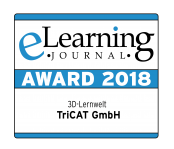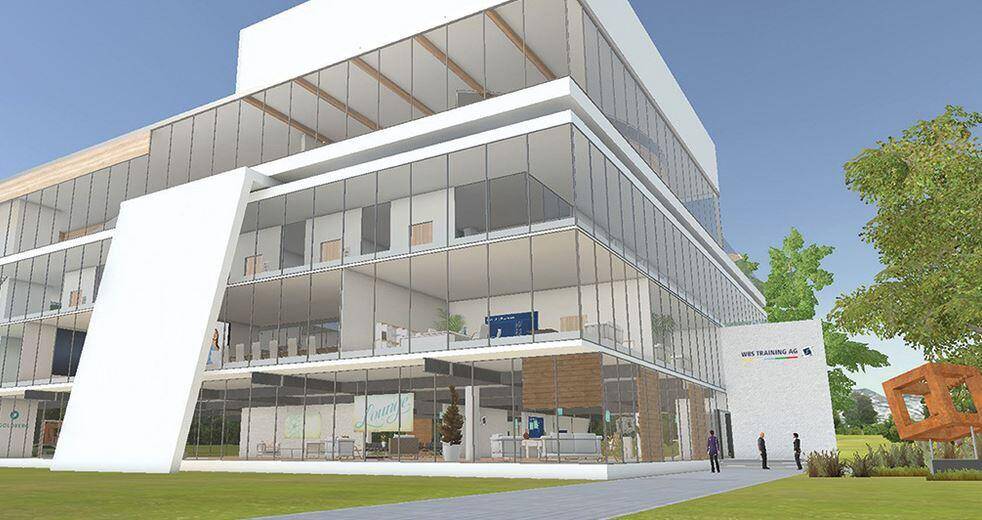Virtual company for WBS TRAINING AG –
With the WBS LearnSpace 3D, the further education specialist WBS TRAINING is launching a virtual continuing education program. The WBS LearnSpace 3D enables new educational experiences in a virtual world of its own. Participants experience what they have learned in virtual but realistic environments, rooms and companies. They can interact and communicate with each other at all levels, i. e. with colleagues and trainers. The WBS LearnSpace 3D enables an ideal preparation for the real world of work.
PROJECT GOAL | CHALLENGE
- Creation of a fully functional training company with realistically designed workstations
- Integration of the social component in a realistically simulated work environment and identification with the role as an employee of a company
- To facilitate work experience, research-based learning and an ideal transfer of theory in order to achieve the greatest possible competence in action
- Experiencing and experiencing the acquired skills and competences
- Enable roughly structured learning processes in individual learning paths for learners
TARGET GROUP
Participants in training courses in balancing, accounting and DATEV
REALIZATION
Virtual illustration of a training company with real processes and process chains including extensive media possibilities
DETAILS
- Implementation of a media library where participants can access learning materials in the form of e-books and videos
- The learners receive progress displays of completed tasks
- Implementation of telephony within the virtual environment
Award for WBS LearnSpace 3D

Interview with Martin Geugis
Member of the management of WBS Training. Written by Julia Tautz in “Weiterbildung”, Digital Learning 7/2017

Mr. Geugis, what is WBS LearnSpace 3D?
WBS LearnSpace 3D is a virtual, three-dimensional simulation that practically complements our further training program. In concrete terms, we carry out practical workshops on various topics in 3D simulation. For example, those who complete further training in the field of accounting, accounting or DATEV can then take part in a practical workshop in the LearnSpace and apply their theoretical knowledge directly in practice. For example, there is the virtual, fictitious training company “GOLDBERG E-Bikes” in which participants gain their first work experience in the field of financial accounting.
How exactly does it work?
Let us stick to the example of financial accounting. Within four weeks, prospective financial accountants complete a whole business year: from the opening balance sheets at the beginning of the year to the closing balance sheets at the end of the year. At the beginning of a working day in the practical workshop, the participants select their own avatar and can move through the WBS LearnSpace 3D with it. Each avatar or participant has his or her own office, in which he or she can carry out typical tasks from the finance department in the morning, for example with regard to liquidity problems, travel expenses or sales commission. The solution of the tasks is carried out independently or in the form of a group work. The LearnSpace Media Library provides all participants with learning materials in the form of e-books or videos on specialist topics.
What didactic learning concept is WBS TRAINING pursuing with LearnSpace 3D?
In the WBS LearnSpace 3D a new educational concept is applied that turns the participants’ learning attitude by 180 degrees. In the trainer lessons, the trainer is responsible for the content and design of knowledge transfer, while the participant is largely passive. Conversely, the participants in the LearnSpace are responsible for their own learning success by solving concrete tasks from the world of work. For this purpose, the 3D simulation provides them with all the resources of a “real” office. The trainer becomes a learning guide, structuring the learning process in a rough way and enabling the participants to follow individual learning paths. This is how a new basic understanding of education is implemented. Knowledge is not only imparted by means of frontal instruction, but also acquired in individual work or in a group session, which is moderated and accompanied by the learning guide, i. e. the trainer. This approach currently reflects the latest didactic state of knowledge transfer. This pedagogical concept has also proved its worth in classical school lessons. In short, it is the transformation from a teaching culture to a learning culture.
How does this relate to learning in a virtual world?
The most effective learning progress is always achieved through positive emotions. New information is most likely to be memorized by an aha-experience, for example when participants put theory into practice. If what has been learnt is embedded in the form of an action, the contents conveyed become much more sustainable. An important moment in this didactic concept is immersion, i. e. the deeper immersion in an operational action process. The more intensive this immersion takes place, the more effective and sustainable the learning progress will be. For our practice workshops and training companies, this means: Using simulation, the participants immerse themselves in the role of a company’s employees. You get your own office, a telephone and a filing room for your documents and you can look out of the window into other offices. When an avatar is inside the simulation to your left, the sound comes from the left – so everything looks very real. Navigation is via mouse and keyboard. Currently there are two courses in the WBS LearnSpace 3D. They show that the participants find their way around in the virtual simulation and like to “work” in the training companies.
What are the advantages for the participants?
Let us take the example of the practice workshop (practical workshop) Financial Accounting. The advantage for the participants lies, for example, in the practical application of financial accounting: from standard bookings to quarterly accounts – all tasks must be processed, exactly as in a real company. The participants’ ability to act is thus made tangible for them. Job advertisements often require practical specialist knowledge, which many participants do not yet dare to apply after further training. Through the practical workshop in WBS LearnSpace 3D, the participants expand and consolidate their theoretical knowledge and acquire practical know-how. In this way, they become more confident and gain practical knowledge that allows them to work on the basis of their own knowledge.
After 3D simulation, what’s the next step in digital learning?
Sometimes we see in courses that participants can’t operate a mouse. I used to say: Then our digital learning concept is not right for them. But today I think that digital understanding can be learned and is indispensable for today’s education. There is no education provider that does not work digitally. True, 3D simulation cannot imitate all the senses, such as smell. However, the operation of complicated machines, for example, can be recreated virtually. I have already seen the use of 3D glasses in the maintenance of a printing machine. With virtual reality glasses and gloves equipped with sensors, the test person first obtained information and then replaced the roller of the printing press – completely virtually. What the test person experienced through the 3D glasses was transmitted on a screen. However, I do not see any essential added value for didactics in the use of 3D glasses. Rather, I think that simulation and virtuality expand and support the possibilities for didactic concepts, but can never replace good knowledge transfer.
Because the most important thing for us is the participants, who can combine work experience, research-based learning and theory transfer in a practical workshop in the WBS LearnSpace 3D. In this way, we realize our understanding of education in an innovative way in the space of the latest technical possibilities and unfold new perspectives for a sustainable, digital learning culture in a development partnership with our partner TriCAT from Ulm.


